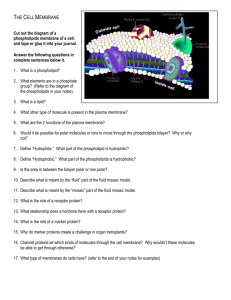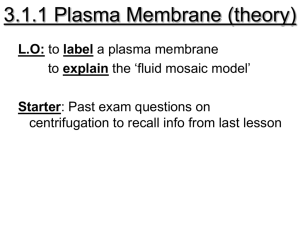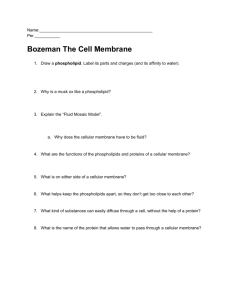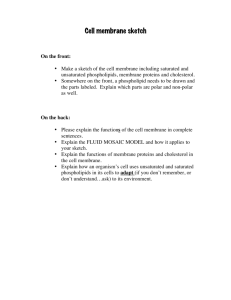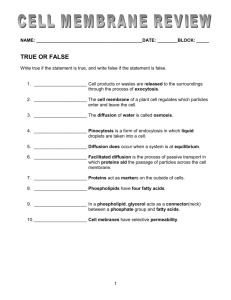Document
advertisement
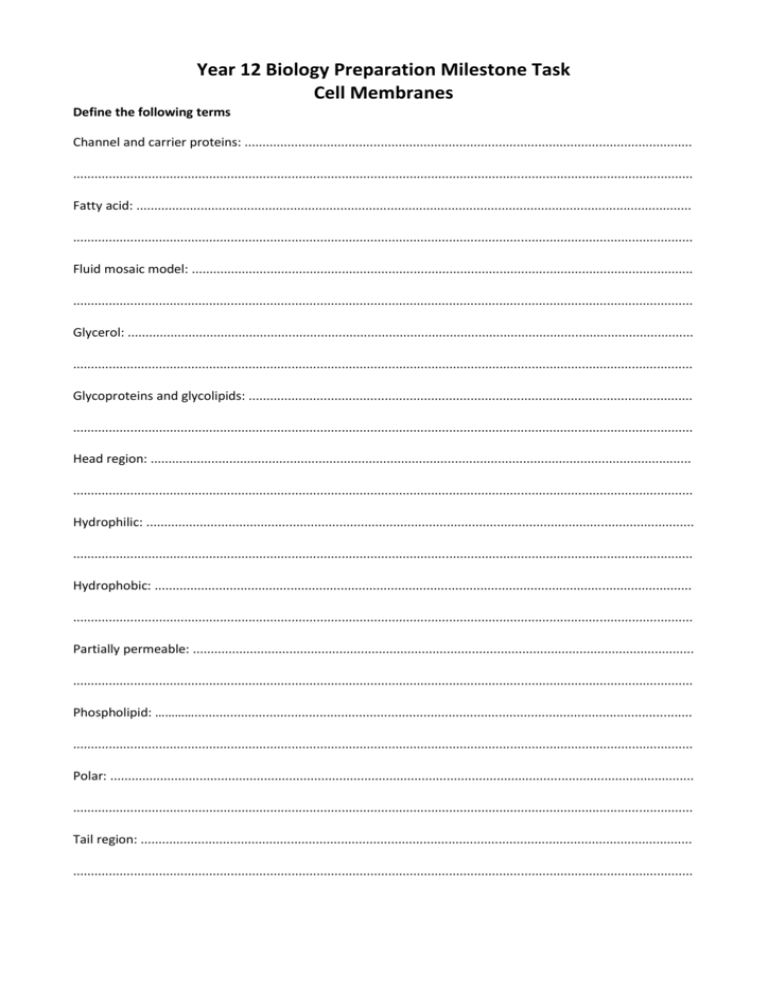
Year 12 Biology Preparation Milestone Task Cell Membranes Define the following terms Channel and carrier proteins: ............................................................................................................................. ............................................................................................................................................................................. Fatty acid: ........................................................................................................................................................... ............................................................................................................................................................................. Fluid mosaic model: ............................................................................................................................................ ............................................................................................................................................................................. Glycerol: .............................................................................................................................................................. ............................................................................................................................................................................. Glycoproteins and glycolipids: ............................................................................................................................ ............................................................................................................................................................................. Head region: ....................................................................................................................................................... ............................................................................................................................................................................. Hydrophilic: ......................................................................................................................................................... ............................................................................................................................................................................. Hydrophobic: ...................................................................................................................................................... ............................................................................................................................................................................. Partially permeable: ............................................................................................................................................ ............................................................................................................................................................................. Phospholipid: …………........................................................................................................................................... ............................................................................................................................................................................. Polar: ................................................................................................................................................................... ............................................................................................................................................................................. Tail region: .......................................................................................................................................................... ............................................................................................................................................................................. Complete the sentences use the words in bold active transport ATP bilayer cell membrane channel concentration condensation energy ester facilitated fatty acid flow fluid mosaic glycolipids hydrophilic hydrophobic large membranes opposite osmosis oxygen partially permeable passive phospholipids polar proteins receptors same specific water Cell ____________ are made of many different molecules. A way for us to understand the cell membrane is the ________ __________ model. The majority of the cell membrane is made of ___________. Phospholipids consist of a glycerol molecule with one attached phosphate group (known as the head) and two attached ________ __________ (known as the tail). Both the phosphate group and the fatty acids are attached by __________ bonds that formed by _______________ reactions. The phosphate group is ___________ and is attracted to water molecules, so is called ______________. The fatty acid tails are non polar and repel water, so are called ______________. This means that the membrane is made up of a ___________ of phospholipids - one layer has the head group on the outside and tails pointing inward towards the tails of the second layer and their head groups on the inside of the membrane. This arrangement allows the phospholipids to '________' past one another, hence the term fluid in the fluid mosaic model. The membrane also consists of __________, these are usually involved in transport. There are also ________________ and glycoproteins that act as _______ and to identify the cell. These other molecules are rotten in and through the phospholipid bilayer, hence the term mosaic in the fluid mosaic model. Cell membranes are described as ____________ _______________ since some things are able to pass through while others cannot. There are many ways in which substances can cross the ______ ________________. Some very small, uncharged molecules like _____________ and carbon dioxide can pass through by diffusion. Although ____________ is polar, it is very small so can also able to pass freely into the cell (the process of water moving from an area where there is a low solute concentration to an area where there is a high solute concentration, across a membrane, is called _______________). _____________ or highly charged particles are unable to pass into the cell by simple diffusion. These molecules are able to enter the cell with the help of ____________ proteins. Channel proteins are highly ____________ so only allow one substance through. The process requires no energy so it is _____________, and is called ______________ diffusion. Passive movement of substances can also occur via ___________ proteins which can move one or two particles at a time: symporters move move one particle down its concentration gradient and another in the _________ direction but up its concentration gradient, antiporters do the same but the particles are moved in _____________ directions. In some circumstances it is necessary for the cell to move substances against a __________________ gradient using carrier proteins. This requires the input of _____________ in the form of _____, and is called ____________ _______________. Active transport normally involves only one type of particle moving in one direction. Answer the questions 1. Draw and fully label a phospholipid molecule that has one saturated and one unsaturated fatty acid in the tail [6] 2. Describe in detail how the phospholipid is formed [3] ............................................................................................................................................................................. ............................................................................................................................................................................. ............................................................................................................................................................................. ............................................................................................................................................................................. ............................................................................................................................................................................. 3. Explain why the plasma membrane is described as a fluid mosaic [2] ............................................................................................................................................................................. ............................................................................................................................................................................. ............................................................................................................................................................................. 4. Name and describe the five ways substances can enter a cell [5] ............................................................................................................................................................................. ............................................................................................................................................................................. ............................................................................................................................................................................. ............................................................................................................................................................................. ............................................................................................................................................................................. ............................................................................................................................................................................. ............................................................................................................................................................................. Answer the exam questions Q1. The diagram shows part of a plasma membrane. (a) Describe two functions of the structure made from the parts labelled X. [2] 1 .......................................................................................................................................................................... ............................................................................................................................................................................. 2 .......................................................................................................................................................................... ............................................................................................................................................................................. (b) Give one function of the molecule labelled Y. [1] ............................................................................................................................................................................. ............................................................................................................................................................................. (Total 3 marks) Q2. (a) Explain how three features of a plasma membrane adapt it for its functions. [6] ............................................................................................................................................................................. ............................................................................................................................................................................. ............................................................................................................................................................................. ............................................................................................................................................................................. ............................................................................................................................................................................. ............................................................................................................................................................................. (b) Explain why the structure of a membrane is described as fluid-mosaic. [2] ............................................................................................................................................................................. ............................................................................................................................................................................. ............................................................................................................................................................................. (Total 8 marks) Q3. The diagram shows the fluid-mosaic model of a cell surface membrane. (a) Name the molecules labelled A and B. [1] A ......................................................................................................... B ......................................................................................................... (b) How does the bilayer formed by substance A affect entry and exit of substances in and out of cells? [2] ............................................................................................................................................................................. ............................................................................................................................................................................. ............................................................................................................................................................................. Q4.(a) Contrast the processes of facilitated diffusion and active transport. ........................................................................................................................ ........................................................................................................................ ........................................................................................................................ ........................................................................................................................ ........................................................................................................................ ........................................................................................................................ (Extra space) ................................................................................................ ........................................................................................................................ ........................................................................................................................(3) Students investigated the uptake of chloride ions in barley plants. They divided the plants into two groups and placed their roots in solutions containing radioactive chloride ions. • Group A plants had a substance that inhibited respiration added to the solution. • Group B plants did not have the substance added to the solution. The students calculated the total amount of chloride ions absorbed by the plants every 15 minutes. Their results are shown in the figure below. (b) Time / minutes Calculate the ratio of the mean rate of uptake of chloride ions in the first hour to the rate of uptake of chloride ions in the second hour for group B plants. Ratio = ................................... :1 (2) (c) Explain the results shown in the figure above. ........................................................................................................................ ........................................................................................................................ ........................................................................................................................ ........................................................................................................................ ........................................................................................................................ ........................................................................................................................ ........................................................................................................................ ........................................................................................................................ ........................................................................................................................ (4) (Total 9 marks) Q5.Omega-3 fatty acids are found in cows’ milk. Scientists investigated changes in the concentration of omega-3 fatty acids in milk when cows were moved from eating grass in fields to eating corn in cattle sheds. The following figure shows the results of one investigation. (a) The concentration of omega-3 fatty acids in milk changed when cows were fed on corn instead of grass. Describe how. ........................................................................................................................ ........................................................................................................................ ........................................................................................................................ ........................................................................................................................ (b) (i) (2) Calculate the rate of decrease in the mean omega-3 fatty acid concentration between 0 and 40 days. Show your working. Answer.......................................................% per day (2) (ii) The omega-3 fatty acid concentration is expressed as a percentage of total fat. Explain the advantage of this. ............................................................................................................... ............................................................................................................... ............................................................................................................... ............................................................................................................... (2) (iii) One farmer concluded from the graph that feeding cows on corn reduces the omega-3 fatty acid content in milk. Evaluate this conclusion. ............................................................................................................... ............................................................................................................... ............................................................................................................... ............................................................................................................... ............................................................................................................... ............................................................................................................... ............................................................................................................... ............................................................................................................... Extra space ........................................................................................... ............................................................................................................... ............................................................................................................... ..............................................................................................................(4) (Total 10 marks)
